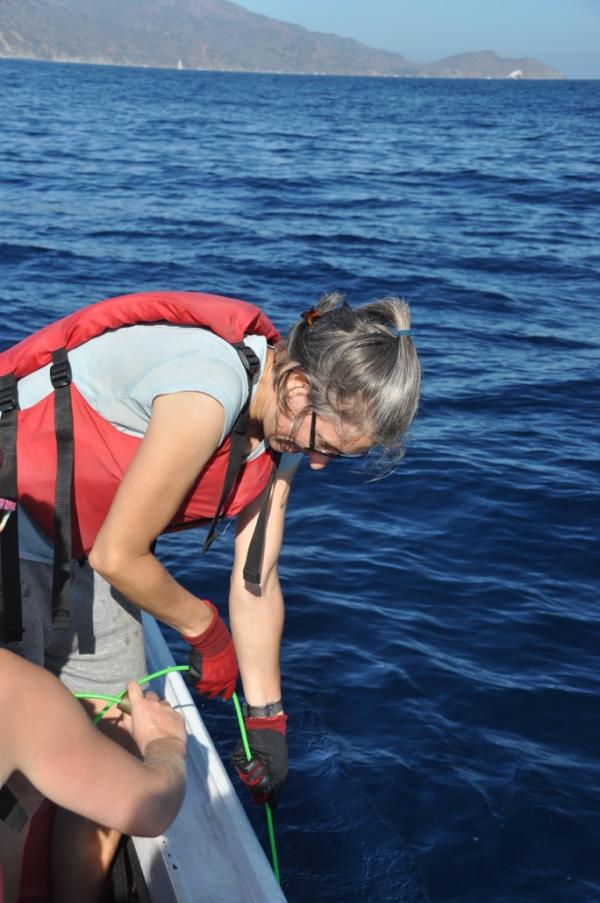Article
Heterotrophic Foraminifera Capable of Inorganic Nitrogen Assimilation
Bird C, LeKieffre C, Jauffrais T, Meibom A, Geslin E, Filipsson HL, Maire O, Fehrenbacher JS & Russell AD (2020) Heterotrophic Foraminifera Capable of Inorganic Nitrogen Assimilation. Frontiers in Microbiology, 11, Art. No.: 604979. https://doi.org/10.3389/fmicb.2020.604979
Article
The genetic diversity, morphology, biogeography, and taxonomic designations of Ammonia (Foraminifera) in the Northeast Atlantic
Bird C, Schweizer M, Roberts A, Austin WEN, Knudsen KL, Evans KM, Filipsson HL, Sayer MDJ, Geslin E & Darling KF (2020) The genetic diversity, morphology, biogeography, and taxonomic designations of Ammonia (Foraminifera) in the Northeast Atlantic. Marine Micropaleontology, 155, Art. No.: 101726. https://doi.org/10.1016/j.marmicro.2019.02.001
Article
Enrichment of intracellular sulphur cycle -associated bacteria in intertidal benthic foraminifera revealed by 16S and aprA gene analysis
Salonen IS, Chronopoulou P, Bird C, Reichart G & Koho KA (2019) Enrichment of intracellular sulphur cycle -associated bacteria in intertidal benthic foraminifera revealed by 16S and aprA gene analysis. Scientific Reports, 9, Art. No.: 11692. https://doi.org/10.1038/s41598-019-48166-5
Article
Metabarcoding Insights Into the Trophic Behavior and Identity of Intertidal Benthic Foraminifera
Chronopoulou P, Salonen I, Bird C, Reichart G & Koho KA (2019) Metabarcoding Insights Into the Trophic Behavior and Identity of Intertidal Benthic Foraminifera. Frontiers in Microbiology, 10, Art. No.: 1169. https://doi.org/10.3389/fmicb.2019.01169
Article
Assessing proxy signatures of temperature, salinity, and hypoxia in the Baltic Sea through foraminifera-based geochemistry and faunal assemblages
Groeneveld J, Filipsson HL, Austin WEN, Darling K, McCarthy D, Krupinski NBQ, Bird C & Schweizer M (2018) Assessing proxy signatures of temperature, salinity, and hypoxia in the Baltic Sea through foraminifera-based geochemistry and faunal assemblages. Journal of Micropalaeontology, 37 (2), pp. 403-429. https://doi.org/10.5194/jm-37-403-2018
Article
16S rRNA gene metabarcoding and TEM reveals different ecological strategies within the genus Neogloboquadrina (planktonic foraminifer)
Bird C, Darling KF, Russell AD, Fehrenbacher JS, Davis CV, Free A & Ngwenya BT (2018) 16S rRNA gene metabarcoding and TEM reveals different ecological strategies within the genus Neogloboquadrina (planktonic foraminifer). PLoS ONE, 13 (1), Art. No.: e0191653. https://doi.org/10.1371/journal.pone.0191653
Article
Cyanobacterial endobionts within a major marine planktonic calcifier (Globigerina bulloides, Foraminifera) revealed by 16S rRNA metabarcoding
Bird C, Darling K, Russell A, Davis C, Jennifer F, Free A, Wyman M & Ngwenya B (2017) Cyanobacterial endobionts within a major marine planktonic calcifier (Globigerina bulloides, Foraminifera) revealed by 16S rRNA metabarcoding. Biogeosciences, 14, pp. 901-920. https://doi.org/10.5194/bg-14-901-2017
Article
The genetic diversity, phylogeography and morphology of Elphidiidae (Foraminifera) in the Northeast Atlantic
Darling KF, Schweizer M, Luise Knudsen K, Evans KM, Bird C, Roberts A, Filipsson HL, Kim J, Gudmundsson G, Wade CM, Sayer MDJ & Austin WEN (2016) The genetic diversity, phylogeography and morphology of Elphidiidae (Foraminifera) in the Northeast Atlantic. Marine Micropaleontology, 129, pp. 1-23. https://doi.org/10.1016/j.marmicro.2016.09.001
Article
Quantitative PCR Profiling of Escherichia coli in Livestock Feces Reveals Increased Population Resilience Relative to Culturable Counts under Temperature Extremes
Oliver D, Bird C, Burd E & Wyman M (2016) Quantitative PCR Profiling of Escherichia coli in Livestock Feces Reveals Increased Population Resilience Relative to Culturable Counts under Temperature Extremes. Environmental Science and Technology, 50 (17), pp. 9497-9505. https://doi.org/10.1021/acs.est.6b02657
Article
A new integrated approach to taxonomy: The fusion of molecular and morphological systematics with type material in benthic foraminifera
Roberts A, Austin W, Evans K, Bird C, Schweizer M & Darling K (2016) A new integrated approach to taxonomy: The fusion of molecular and morphological systematics with type material in benthic foraminifera. PLoS ONE, 11 (7), Art. No.: e0158754. https://doi.org/10.1371/journal.pone.0158754
Article
Denitrifying alphaproteobacteria from the Arabian Sea that express nosZ, the gene encoding nitrous oxide reductase, in oxic and suboxic waters
Wyman M, Hodgson S & Bird C (2013) Denitrifying alphaproteobacteria from the Arabian Sea that express nosZ, the gene encoding nitrous oxide reductase, in oxic and suboxic waters. Applied and Environmental Microbiology, 79 (8), pp. 2670-2681. https://doi.org/10.1128/AEM.03705-12
Article
Transcriptionally active heterotrophic diazotrophs are widespread in the upper water column of the Arabian Sea
Bird C & Wyman M (2013) Transcriptionally active heterotrophic diazotrophs are widespread in the upper water column of the Arabian Sea. FEMS Microbiology Ecology, 84 (1), pp. 189-200. https://doi.org/10.1111/1574-6941.12049
Article
Lack of Control of Nitrite Assimilation by Ammonium in an Oceanic Picocyanobacterium, Synechococcus sp. Strain WH 8103
Wyman M & Bird C (2007) Lack of Control of Nitrite Assimilation by Ammonium in an Oceanic Picocyanobacterium, Synechococcus sp. Strain WH 8103. Applied and Environmental Microbiology, 73 (9), pp. 3028-3033. https://doi.org/10.1128/AEM.02606-06
Article
Spatial distribution and transcriptional activity of an uncultured clade of planktonic diazotrophic γ-proteobacteria in the Arabian Sea
Bird C, Martinez Martinez J, O'Donnell AG & Wyman M (2005) Spatial distribution and transcriptional activity of an uncultured clade of planktonic diazotrophic γ-proteobacteria in the Arabian Sea. Applied and Environmental Microbiology, 71 (4), pp. 2079-2085. https://doi.org/10.1128/AEM.71.4.2079-2085.2005
Article
Nitrate/Nitrite Assimilation System of the Marine Picoplanktonic Cyanobacterium Synechococcus sp. Strain WH 8103: Effect of Nitrogen Source and Availability on Gene Expression
Bird C & Wyman M (2003) Nitrate/Nitrite Assimilation System of the Marine Picoplanktonic Cyanobacterium Synechococcus sp. Strain WH 8103: Effect of Nitrogen Source and Availability on Gene Expression. Applied and Environmental Microbiology, 69 (12), pp. 7009-7018. https://doi.org/10.1128/AEM.69.12.7009-7018.2003

